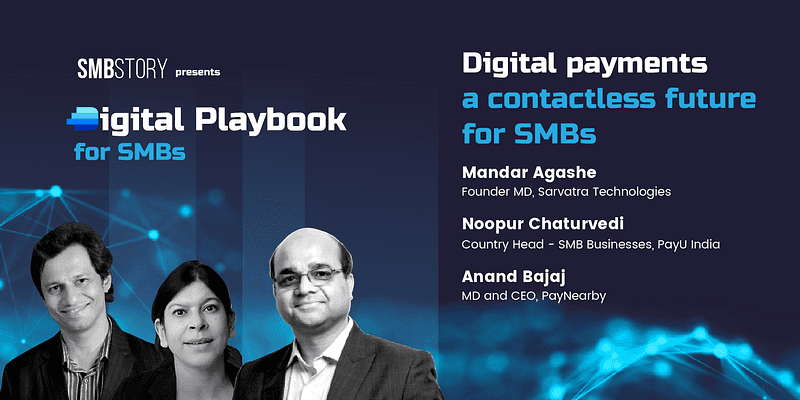Why digital payments will enable a contactless future for Indian SMBs
On SMBStory’s Digital Playbook for SMBs, three leading Indian digital payment solution providers came together to describe how contactless payments will become the norm, and how SMBs should adopt them.
Ever since India went into lockdown in March 2020, consumer behaviour shifted online. They increasingly relied on digital platforms for groceries, education, and other essentials.
This shift taught all stakeholders in the small and medium businesses (SMB) ecosystem the importance of enabling digital, contactless payments for small businesses, kiranas, and merchants.
Digital payment solution providers now believe contactless payments are here to stay, even as the country relaxes lockdown rules and unlocks in stages.
On SMBStory’s Digital Playbook for SMBs, three leading Indian digital payment solution providers came together to describe how contactless payments will become the norm and explained how SMBs should adopt them.
SMBStory’s Digital Playbook for SMBs is a video series that covers the crucial areas of SMB digitisation. It explores digital payments, ecommerce, digital bookkeeping, cloud, security, CRM, automation, AI/ML, blockchain, and other software solutions, products, and emergent technologies.
“Consumers across the world are adopting digital payments and are becoming more comfortable doing transactions online. I believe this behaviour will continue even post-pandemic. Its unlikely customers will stop using digital payments once all stores reopen,” Noopur Chaturvedi, Country Head - SMB Businesses, PayU India, said during the virtual discussion.
According to her, SMBs and merchants used to be content with using traditional ways of accepting payments. But, after the pandemic, there is a surge in interest from offline merchants for digital solutions. She believes having an online presence will help SMBs connect with customers and attract business.
Anand Kumar Bajaj, MD and CEO, PayNearby, said, “Kirana stores remained open during the lockdown. There was pressure from customers for kiranas to accept digital payments. Kiranas that were uncertain about GST earlier ended up adopting new methods of transacting online. This new behaviour of contactless transactions will become deep rooted.”
Mandar Agashe, Founder and MD, Sarvatra Technologies, who works to digitally enable banks, said,” Nobody wants to go to a bank branch and risk becoming exposed to the coronavirus. So there is a demand for banks, especially cooperative banks, to adopt digital platforms and run despite physical branches being empty.”
A growing market for digital payments
Noopur, Anand, and Mandar’s belief in the contactless future for SMBs is backed by data suggesting digital payments in India will grow substantially over the next five years.
According to a report by , digital payments in India are expected to grow over three-fold to Rs 7,092 trillion by 2025 from Rs 2,162 trillion in 2019-20. The report attributes government policies around financial inclusion and growing digitisation of merchants as primary factors for the growth.
The report also estimated that India’s current 160 million unique mobile payment users will multiply by five times to reach nearly 800 million by 2025.

Noopur Chaturvedi, Country Head - SMB Businesses, PayU India
In April 2020, the closure of ecommerce sites for non-essential items, restaurants, and others caused a dip in transactional value for UPI payments.
But by May, the UPI transactions surged. In that month, total transaction volumes for consumers were the highest on Google Pay, followed by , and . On the merchant side, the highest was on PhonePe.
By July, the digital payments transactions had rebounded and reached pre-COVID levels. This was despite the lockdown causing contraction in the Indian economy.
NPCI data showed UPI clocked 1.49 billion transactions worth Rs 2.9 trillion in July 2020. In August 2020, UPI volumes touched 1.61 billion transactions worth Rs 2.98 trillion.
The technology for digitising purchases and payments has the potential to completely transform the way India does business. The digitisation of payments is introducing much-needed simplicity, streamlining business processes, reducing timelines, and improving overall efficiency for SMBs.

Mandar Agashe, Founder, MD and Vice President, Sarvatra Technologies
How SMBs should adopt digital payments
Indian businesses of all sizes — right from neighbourhood kirana stores to larger SMBs — are embracing digital payments at a breakneck pace.
However, it can be overwhelming for an SMB or merchant to decide which digital payments platforms to use.
PayU India’s Noopur said, “SMBs should go with the suggestions of a player they trust or a brand name they have worked with before. Or, it can be a player that someone in their close circle has worked with before. There are a number of fly-by-night operators who might have payment platforms, but SMBs might lose their money if they work with them.”
The three speakers also agreed SMBs shouldn’t invest a lot of time, energy, and money on issues that aren’t their core business problem. SMBs may tend to allocate substantial resources towards financial management if they use a number of payment solutions for different transactions.

Co-founders of Nearby Technologies (L to R): Anand Kumar Bajaj, Yashwant Lodha, Subhash Kumar and Rajesh Jha
Instead, SMBs should simplify the process and use a singular digital payments platform that offers all the required payment solutions.
“Trust is the most important [sic] in digitally enabling payments. Generally, SMBs first ask their bank which digital solution they can provide. Their basic trust is with their bank as they keep deposits there and take loans. So, SMBs can also go to their banker or a trustworthy merchant who has been around for a long time,” said Mandar.
This accelerated adoption of digital solutions for payments and banking is now creating a large business opportunity for building such platforms and products.
A 2019 report estimated the total digital opportunity offered by Indian MSMEs will grow from around $30 billion in 2019 to $85 billion in 2024. The real opportunity could, in fact, be much bigger in the wake of the COVID-19 pandemic.
Advising startups and tech enterprises that want to build such products and solutions, Anand said, “SMBs are going to stick with trusted partners, even if it's with a payment solution offered by a nearby merchant. Therefore, merely having an idea for building such a solution does not help. A lot of support, networking, and partnerships are needed. Payments solutions will succeed based on how utilitarian they are and how difficult they are to copy.”
Edited by Suman Singh











